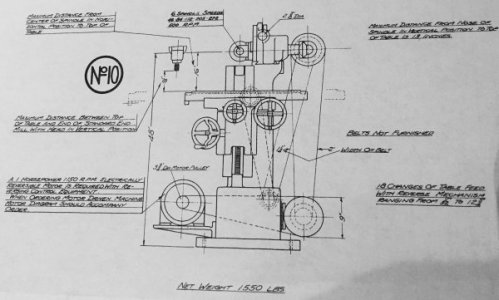- Joined
- Feb 7, 2016
- Messages
- 172
My Van Norman no 10 mill came with a baldor 1725 rpm motor. I currently have the motor being inspected to find out the condition and curious if the motor is too big for my machine. Currently it is a L1322T 2hp 1725rpm.
Originally VN calls for a 1hp 1150 rpm motor but I do not have the original stepped pulleys (flat belt) Equipped to the machine are 4 stepped v belt pulley's in steps of roughly 3", 4.5", 5.5" and 7". My low speed gear is 23/46 while the high speed is 33/36. The motor pulley is roughly 3.5" that transmits to a 9" pulley, which is original for this machine.
So I will try to explain the lay out of the pulleys:
3.5" transmits to 9"
9" pulley is on the same shaft as one stepped pulley
3" step transmits to 7" step on other stepped pulley
4.5" transmits to 5.5"
5.5" transmits to 4.5"
7" transmits to 3"
The second stepped pulley transmits to the low/high gear box
23/46 low
33/36 high
My rpm at the spindle are roughly (w/ 1725 initial input rpm)
Low-125, 238, 356, 680
High-229, 436, 652, 1245
A 1150 rpm motor would give me roughly:
Low-74, 141, 210, 402
High-135, 253, 378, 721
If I used a 2" motor pulley with the 1725 rpm motor I would end up very similar to the 1150rpm figures.
Originally Vn has rpm 46-84-112-205-272-500. Will the 1245 rpm damage the brass bushings? Would be nice to have the rpm for small end mills but not at the expense of destroying the machine.
I already am considering a brand new motor and want to make sure I will not over run the machine.
Any experience, advise, ideas, help would be greatly appreciated.
Originally VN calls for a 1hp 1150 rpm motor but I do not have the original stepped pulleys (flat belt) Equipped to the machine are 4 stepped v belt pulley's in steps of roughly 3", 4.5", 5.5" and 7". My low speed gear is 23/46 while the high speed is 33/36. The motor pulley is roughly 3.5" that transmits to a 9" pulley, which is original for this machine.
So I will try to explain the lay out of the pulleys:
3.5" transmits to 9"
9" pulley is on the same shaft as one stepped pulley
3" step transmits to 7" step on other stepped pulley
4.5" transmits to 5.5"
5.5" transmits to 4.5"
7" transmits to 3"
The second stepped pulley transmits to the low/high gear box
23/46 low
33/36 high
My rpm at the spindle are roughly (w/ 1725 initial input rpm)
Low-125, 238, 356, 680
High-229, 436, 652, 1245
A 1150 rpm motor would give me roughly:
Low-74, 141, 210, 402
High-135, 253, 378, 721
If I used a 2" motor pulley with the 1725 rpm motor I would end up very similar to the 1150rpm figures.
Originally Vn has rpm 46-84-112-205-272-500. Will the 1245 rpm damage the brass bushings? Would be nice to have the rpm for small end mills but not at the expense of destroying the machine.
I already am considering a brand new motor and want to make sure I will not over run the machine.
Any experience, advise, ideas, help would be greatly appreciated.


